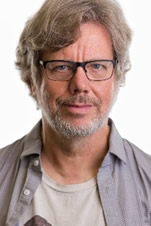2023 Recipients of C&C Prize
Group B

Guido van Rossum
Distinguished Engineer, Microsoft Corporation
Citation
For Major Contributions to the Development of the Python Programming Language and its Use as Open-source Software
Achievements
The rapid evolution of digital technologies such as computing, 5G, Internet of Things (IoT), artificial intelligence (AI), and data science is driving a digital transformation (DX) and the ongoing creation of new services and business models, most of which are implemented by software. Softwarization makes the development of complex processes and tasks more efficient, enables developers to keep up with rapidly evolving digital technologies, shortens development times from brainstorming to implementation, and facilitates flexible system development according to needs.
Guido van Rossum, known as the father of the Python programming language, led the Python development community and was heavily involved in the design and development of the language. His vision was to make Python into a simple and easy-to-read language capable of efficient programming. Today, Python is supported by a wide range of programmers from beginners to specialists for use in a variety of applications and services.
In 1989, Van Rossum, on thinking, “If only there was a language that was easier to use,” began development of a new programming language that would feature both easy-to-read code and efficient programming. He released the first version of Python in 1991. The Python development community was born, which Van Rossum led as the benevolent dictator for life (BDFL) having the right to make final decisions on the direction of and changes to Python while receiving proposals and feedback from the community. Then, in 1994, Python 1.0 was released incorporating the fundamental elements of Python syntax including the concept of basic types and object-oriented programming.
Around this time, the development of Python began to grow as an open -source project and a variety of programmers came to be involved. Van Rossum’s vision and design concept influenced the features and philosophy of Python and drove the further development of the language. In 1999, he described the following goals for Python in a funding proposal that he submitted to DARPA (Defense Advanced Research Projects Agency, a research and development agency of the United States Department of Defense):
・An easy and intuitive language just as powerful as the major competitors
・Open source, so anyone can contribute to its development
・Code that is as understandable as plain English
・Sustainability for everyday tasks allowing short development times
“Zen of Python” (Tim Peters, 1999), a collection of guiding principles that summarize the basic philosophy of Python, is shared within the Python community.
Van Rossum also proposed the Python Enhancement Proposal (PEP) process in 2000. This is a mechanism for advancing the development of Python and making improvements. It enables proposals for new functions and changes to be made in a systematic manner and a consensus to be built within the community through discussions and evaluations.
In 2001, the Python Software Foundation (PSF) was established for the purpose of promoting, supporting, and protecting the Python project. It is the core organization of the Python community engaged in diverse activities such as Python development, distribution, education, and licensing. Until recently, Van Rossum served as President of the PSF.
With the release of Version 2 in 2000, Python became increasingly popular, and the release of Version 3 in 2008 established Python as a mature programming language. Python has found use in a variety of fields such as Web applications, data science, machine learning, AI, and automation. In 2018, Van Rossum retired from his position as BDFL and the Python community shifted to a new leadership system, but he is nevertheless still deeply involved with the Python community to this day.
Python is an interpreter-type, high-level, general-purpose programming language. The following points have been offered as Python features and reasons for its popularity:
(1) Python uses simple and easy-to-read syntax. It is easy to learn and understand even for beginners.
(2) Python includes an extensive standard library enabling developers to create programs efficiently. Designed as a “batteries included” (ready to use) language, simply installing Python enables a developer to start developing diverse functions from file operations to database operations as well as network communications, graphical user interface (GUI) applications, etc. Python is particularly strong in having extensive AI third-party libraries for machine learning and other advanced functions.
(3) Python enables the use of a variety of frameworks (toolsets that provide a platform or structure for efficiently developing applications or software) such as Web applications and AI so that developers can develop high-quality, efficient programs.
(4) Python runs on various operating systems (OSs).
(5) Python’s wide-ranging community provides high-quality documentation, forums, and tutorials enabling developers to actively engage in information sharing and mutual support. Many third-party libraries and frameworks are also provided.
Guido van Rossum’s vision, leadership, and contributions to the Python community have had a major impact on the world of programming. Thanks to its ecosystem (peripheral environment) of abundant libraries, frameworks, and tools, Python is being used in a wide variety of software applications that are contributing greatly to the development of society. In view of the great contributions that he has made to the development of the Python programming language and its use as open-source software, Guido van Rossum is a deserving recipient of the C&C Prize.
